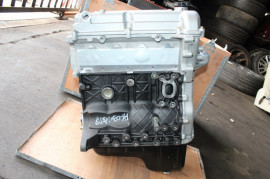How to Pick the Right Opel Corsa Engine for Your Automobile
How to Pick the Right Opel Corsa Engine for Your Automobile
Blog Article
Exploring the Inner Operation of a Compact Automobile's Engine System
As drivers, we often consider provided the intricate procedures that happen within the confines of our vehicle's engine system. The small yet complicated machinery that propels us ahead is a marvel of design accuracy and sychronisation. From the regulated explosions in the combustion chamber to the careful timing of gas injection, every part plays a vital function in the smooth procedure of the engine. In this exploration of a portable car's engine system, we will untangle the inner operations of this mechanical symphony, clarifying the enigmas that drive us onward on our everyday journeys.
Combustion Refine Review
The combustion process in a compact car's engine system is an essential mechanism that successfully converts fuel into energy to power the lorry. This process occurs within the burning chamber of the engine, where gas and air mix, ignite, and produce regulated explosions. The combustion process is composed of 4 main stages: consumption, compression, power, and exhaust.
Throughout the intake phase, the piston moves downward, pulling in a mixture of air and fuel right into the combustion chamber. The next stage, compression, involves the piston moving upwards, compressing the air-fuel mixture to raise its strength. Ultimately, in the power stage, the trigger plug sparks the pressed mix, causing a fast development of gases that forces the piston pull back. This downward motion creates the power needed to drive the automobile. Finally, in the exhaust phase, the burnt gases are eliminated from the combustion chamber via the exhaust valve, preparing the chamber for the following cycle. This cyclic combustion procedure is fundamental to the operation of a small lorry's engine system, making sure reliable energy conversion for propulsion.
Piston and Cyndrical Tube Communication

The piston's accurate fit within the cylinder is vital for preserving ideal compression and stopping power loss throughout burning. Tight clearances between the piston and cylinder walls guarantee efficient sealing, allowing the piston to relocate efficiently without permitting gases to leakage past. Appropriate lubrication is likewise important to decrease friction and wear between these parts, boosting long life and efficiency.
Additionally, the style and materials utilized in making the piston and cylinder influence engine performance and durability. Modern engines often use light-weight yet long lasting materials like light weight aluminum alloys for pistons and cyndrical tube liners to reduce inertia and boost thermal performance. Generally, the harmonious communication between the piston and cyndrical tube is essential to the engine's performance and overall efficiency.
Gas Injection System Capability
Fuel shot systems in small car engines play a crucial duty in exactly delivering gas to the combustion chamber for reliable and controlled ignition. The gas injection system operates by injecting gas into the burning chamber at the optimal minute during the engine's procedure (opel corsa engine). This exact timing ensures that the gas his response blends evenly with the air for appropriate combustion, bring about enhanced gas effectiveness and lowered discharges
There are primarily two sorts of fuel shot systems used in small lorry engines: port fuel shot (PFI) and straight gas shot (DFI) PFI systems infuse fuel into the intake port prior to the consumption valve, while DFI systems infuse gas straight into the combustion chamber. Both systems have their advantages, with DFI supplying better gas atomization and PFI giving a more cost-efficient solution.
Comprehending Engine Air Conditioning Mechanisms
Reliable operation of a small vehicle's engine relies greatly on the efficiency of its cooling systems. The cooling system in a portable automobile normally consists of several parts working with each other to manage the engine temperature. Understanding these engine air conditioning systems is vital for keeping the performance and long life of a small vehicle's engine system.

Exhaust System Components Explained
The go to the website ideal performance of a portable automobile's engine cooling mechanisms relies on a complementary system referred to as the exhaust system, which makes up various essential parts for making sure efficient exhausts and engine performance. The exhaust system consists of elements such as the exhaust manifold, catalytic converter, muffler, and tailpipe. The exhaust manifold accumulates exhaust gases from the engine's paths and cyndrical tubes them to the catalytic converter. The catalytic converter then converts unsafe contaminants in the exhaust right into less hazardous emissions prior to releasing them with the muffler and tailpipe.
One vital part of the exhaust system is the oxygen sensor, which keeps an eye on the oxygen degrees in the exhaust gases to aid regulate gas intake and guarantee ideal engine efficiency. opel corsa engine. Additionally, the resonator may be existing in some exhaust systems to lower noise levels. Generally, the exhaust system plays an essential role in preserving engine effectiveness, lowering hazardous discharges, and making sure a quieter driving experience for portable automobile proprietors

Final Thought
In verdict, the portable vehicle's engine system is a complicated mix of parts that work together to help with the burning procedure, transform gas right into power, and expel waste gases. Comprehending the inner functions of the engine system, consisting of the piston and cyndrical tube communication, gas shot system, engine cooling systems, and exhaust system parts, is crucial for preserving optimum performance and effectiveness of the vehicle.
The combustion process in a portable vehicle's engine system is a critical system that effectively transforms gas right into power to power the vehicle.Fuel injection systems in small automobile engines play an essential role in precisely delivering fuel to the combustion chamber for efficient and controlled ignition.There are primarily 2 kinds additional info of gas injection systems used in compact vehicle engines: port gas shot (PFI) and straight gas shot (DFI) Recognizing these engine cooling mechanisms is vital for maintaining the efficiency and longevity of a compact lorry's engine system.
The optimum functioning of a compact lorry's engine air conditioning systems depends on a complementary system understood as the exhaust system, which makes up various vital components for ensuring reliable emissions and engine efficiency.
Report this page